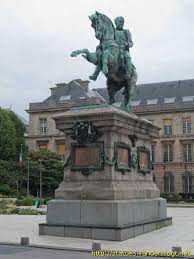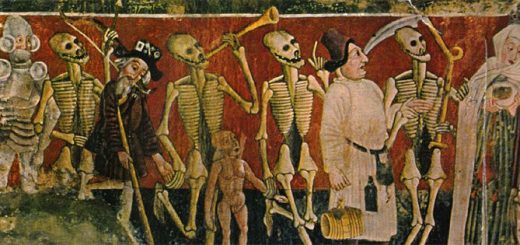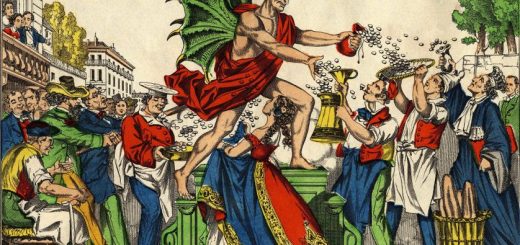«Montjoie! Saint-Denis!» Cancel Culture and the Historian

How should historians respond to the claims of what is currently called ‘Cancel culture’?
“La verité…Comme si quelqu’un savait cexé. Tout ça (geste), tout ça c’est du bidon : le Panthéon, les Invalides, la caserne de Reuilly, le tabac du coin, tout. Oui, du bidon. »
(Raymond Queneau, Zazie dans le métro, 1959)
In recent times not only invasive historical characters such as Christopher Columbus, Napoleon or Winston Churchill, but far more tranquil personalities like David Hume, Adam Smith and Jane Austen have become the targets of some politically correct autodafé; even random artifacts, somehow implicated in the supposed misdeeds of their original owners, have come under attack. In many cases what is reproached to those figures (or things) of the past is some connection with slavery and colonialism; in other instances, it is racial or gender discrimination: a few of the allegations are quite straightforward; many are vague and confused and, at closer inspection, seem difficult to prove.
A building in the University of Edinburgh called the David Hume Tower is going to be renamed on account of some “racist epithets” – politically incorrect expressions rather common (and not considered offensive) in 18th century Enlightenment literature – present in the Scottish philosopher’s oeuvre. By association the monumental grave of his friend Adam Smith along the Royal Mile has also been placed by some Edinburgh collective on a list of sites ‘associated with slavery’, though Smith condemned the trade in his writings as both immoral and economically dysfunctional.[1] In Cambridge the ‘Demerara Bell’, an 18th century heirloom gifted to St Catharine’s College in the 1950s, has been taken down and is now being investigated by some ad hoc Committee on account of its donor’s possible association with colonialism in British Jamaica. The writer Jane Austen has come under accusation because her novel of 1814 Mansfield Park – in which one of the characters owns properties in Antigua – does not express disapproval of the slave trade; the Austen family’s possible ownership of stocks linked to the trade has also been investigated, thus far with mixed and inconclusive results. That Austen had no control over her father’s financial arrangements, or that no other contemporary political issue is discussed in her works, does not seem to have been taken into consideration.[2] Closer home, in Neuchâtel, the statue of the 18th century local “philanthropist” David de Pury has been vandalized on account of the suspicious origins of his commercial fortune. These are just a few instances.
Clearly the desire of European nations to investigate and question their own colonial past and its abuses is understandable and entirely legitimate. Significant parts of their history are open to reconsideration in the light of what we now think about race or gender biases. What is surprising, on the other hand, is the iconoclastic fury directed against the remnants of distant historical figures, as if – rather than mementos of the past – they were the marks of hated dictators whose rule has just been upturned.
Swapping statues
Sometime ago the municipality of Rouen removed a bronze statue of Napoleon I in need of restauration. Some local group then suggested that the statue should not be returned to its original location but replaced by a statue of the feminist lawyer Gisèle Halimi, recently deceased. As the idea was to remedy the neglect of distinguished female personalities, it is unclear why Halimi should not be entitled to a statue of her own regardless of what happened to Napoleon’s (as the subject of the statue is shown balancing acrobatically on a rearing horse, a straight replacement seems impracticable). A petition was circulated to save the equestrian emperor, and the mayor of Nice, Christian Estrosi, intervened with the suggestion that, if Rouen no longer wanted Napoleon, Nice should be happy to take him. Possibly he was hoping for a counterweight to the oppressive monument to Giuseppe Garibaldi that dominates the homonymous square in town – but then if one were to look more closely at the career of the “Eroe dei Due Mondi” it might be possible to dig up some dirt on him as well: he was an abolitionist, but his South American escapades and marital record do look suspicious.
Having signed (with some 8.000 other people) the keep-Napoleon petition, I began receiving sympathetic messages from a Bonapartist collective calling themselves Les chemises blanches: needless to say, I meant to preserve a historical monument, not to restore the first empire, or indeed any other empire. Suddenly I felt like the protagonist of one of Umberto Eco’s novels: having dismissed as absurd the possibility of a conspiracy organized by the Knights Templar (the subject of his doctoral thesis) he discovers that some group of lunatics calling themselves just that are pursuing him, and planning to kill him, for some obscure motive connected to their plot.[3] There is a strong temptation to set aside some of the undertakings of Cancel culture as misguided, ill-informed, or simply ludicrous: unfortunately, the joke is on us, as the long term impact of such initiatives is bound to prove significant.
The Time Machine
Cancel culture is especially disturbing for historians because one of the fundamentals of their trade is that the past must always be handled with great care. No matter how close the historian may feel to the subject of her research – individuals, places, documents, memorable days – no matter how vividly they fill her imagination, she does know that the past is always profoundly alien and remote. Most of the time historians are in the position of anthropologists observing the practices of some exotic tribe. This is true even of the study of recent events: a single generation is sufficient to mark a distance in language, attitude, and sensibility; it is a fortiori even more true of thoughts and actions belonging to the past centuries. One of the implications of this distance is that our understanding of the past is always, to some extent, faulty and deceptive: we struggle to make it as accurate as possible, but, in the end, we have to accept that we continue to observe it from the perspective of a parallel universe.
Historical research is a sedentary form of time-travel. As countless science fiction narratives have shown, stepping back (or forward) in time, is intrinsically dangerous. In the case of historians, the danger is not a physical one: we are not going to be attacked by armored knights on the shores of the Dordogne like the protagonists of Michael Crichton’s Timeline (1999) or implicated in Kennedy’s assassination as in Stephen King’s 11/22/63 (2011). One can relive the meeting of the Convention that sent Robespierre to the guillotine, or contemplate the massacre of the Communards, from the safety of the computer screen. The risk for the sedentary traveler is rather the cognitive one of misunderstanding and distorting what she is trying to reconstruct; of projecting present values and sensibilities into actions and words that answered to an entirely different logic.
The risk is even greater today than it was fifty or a hundred years ago, as technology has created a deceptive illusion of physical proximity to the objects of one’s studies. Millions of pages of archives are digitalized, battlefields are turned into large videogames, historic buildings that no longer exist can be reproduced on screen complete of their occupants; even the features of long dead individuals can be brought to life with the vividness of photography. While this power of recreation has considerable didactic potential, as it makes history attractive to a wider public, it has also the effect of confusing things: what we see seems real, but it is still, to all effects, a fabrication.
Under the Oriflamme
On the whole historians are well aware of the limitations of their means and of their narratives. Instead, the attitude of the militants of Cancel culture is reminiscent of the popular French comic film Les Visiteurs (1993), in which the medieval knight Godefroy de Montmirail and his serf Jacquouille La Fripouille are magically transported into the 20th century: frightened and confused by modern inventions, the heavily armed pair react by attacking with gusto all object they regard as “diabolical”, hacking it to pieces. Cancel culture does that, as it were, in reverse, striking at random past people and events, of which often very little is known, in the name of some unspecified modern grievance. There are plausible socio-historical explanations for the indiscriminate character of these assaults, such as the decline of more structured forms of political opposition, the disappearance of disciplined experiences of militancy or the solipsistic nature of much present discontent.[4] This shift in the make up of popular protest does no doubt account to some extent for the indiscriminate use of historical references.
If you feel the compulsion to slap the French president, why shouting: “Montjoie! Saint-Denis!”? Why not using some modern expression, like: “Dégage!”, or even the presidential: “Casse-toi pauvre con!”?[5] One possible answer is that, in the absence of established slogans or mythical figures – like those who accompanied the social movements of the past decades – some heroic-sounding, vaguely patriotic battle cry seems better, more dignified, that a mere personal insult. On the occasion of the “Montjoie! Saint-Denis!” incident, the press has evoked the counter revolutionary revolt of the Vendée and the Action française: these may well be the symbolic referents of some hazy royalist-cum-right-wing galaxy, though the author of the assault denied having any connection with these.
Somehow the enhanced potential of time travel has generated a form of digital time tourism, and the Chevalier de Charette or Pierre Poujade are probably no more influential than videogames like “Crusader Kings” or the ever-recurrent tv series on the Templars. For those who can still remember the 1970s the outcome is somewhat disconcerting: liberated from the austere charms of Marx, Lenin and Mao, we are now unaccountably stuck with Charlemagne, for no better reason than the aesthetic appeal of the Oriflamme, medieval weaponry and martial arts.
Sitting in Judgment
Does the distance that separates us from the past mean that we should not judge it? Are individual and collective actions placed beyond the reach of moral consideration by the mere passing of time? Of course not: replacing people and events in their context, acknowledging the shifts in values and mentalities does not remove our capacity to recognize injustice and suffering. Historical research can contribute to bring to light past crimes and abuses, to give voice to victims that went unheard, to open new fields of inquiry; it can also lift prejudices and instrumental accusations that time has proved to be false. However, this process of revision is only possible by the preservation and extension of memory, not by its suppression.
In many cases, this critical exercise is more likely to produce complex, uncertain verdicts, than clear cut ones. Take Napoleon, for example: on the occasion of the recent bicentenary, it has been insistently recalled that in 1802, as First Consul, he officially reestablished slavery in the French colonies, while the Convention had abolished it in 1794. This betrayal of the revolutionary ethos of the rights of man was a serious misjudgment on his part, as he himself admitted in later years. However, if we look at the question more closely, we find that the 1794 decree was never enforced: the powerful lobby of plantation owners swiftly replaced “slavery” with the “forced labor” of the “freed” slaves, keeping them at work in the fields. Moreover, the Convention did not intervene on the subject of the slave trade, considering it (probably rightly) beyond their control. In this instance the discontinuity in principles and rhetoric hides the basic continuity in French colonial practices, with economic considerations clearly prevailing over principles.
On other issues of individual rights, Napoleon followed and consolidated the conquests of revolutionary legislation. The Civil code of 1804 preserved the institution of divorce, introduced by the Assembly in 1792 as essential to promote the happiness of the nation protecting men from scheming and grasping wives.[6] Similarly, the Penal code of 1810 left out the sanctions against “sodomy”, confirming the choice of the Assembly, that had dropped them in 1791. Both these initiatives were fueled by the desire to oppose the influence of the Catholic church rather than by any liberated conception of family values or sexual practices. Under the Ancien Regime divorce was simply incompatible with Catholic precepts, while “sodomy” (punishable by death) belonged to the category of offenses against religion, such as blasphemy or desecration, and disappeared from French penal law together with them. In both cases the cause of individual freedom was served for motives that were different from what we might imagine today.[7]
Hashtag: balance ta cloche!
We cannot turn to past experiences for guidance in present struggles and revendications unless we do know what they were really about to begin with. Following a Cancel logic, ancient monuments, as well as modern towns, should be destroyed, as they were built by slaves or by exploited workers; the stones carrying the names of soldiers killed in the various wars should be pulled down, as they can be seen as glorifying militarism; the remnants of concentration camps should be razed to the ground, as they are clearly associated with Nazi crimes. Every time I walk past the church of Saint-Germain- l’Auxerrois in Paris I cannot help recalling that it was its bell “Marie” that, on the night of the 23rd August 1572, sounded the tocsin, calling the faithful to exterminate their Protestant neighbors. Today “Marie” is still in place; unlike the Demerara Bell in Cambridge, she is not the subject of a special investigation. Her crime – giving the signal for the massacre of the Saint-Barthélemy – is well known, and modern Europe has learnt to live with the memory of the atrocities of the religious wars. During the middle-ages it was common practice to put inanimate objects on trial if they had caused some serious damage to humans: surely this is a time-travel experience we can do without.
Biancamaria Fontana is Emeritus professor of History of political thought at the University of Lausanne, and a member of the Walras Pareto Centre for the history of economic and political thought. Her last book is on La République helvétique, laboratoire de la Suisse moderne.
Footnotes
- Daniel B. Klein, “Adam Smith’s 1759 Rebuke of the Slave Trade”, The Independent Review, 2020, 25(1), 91-98. ↩
- For a summing up of the disputes around Austen see: Devoney Looser, “Breaking the Silence”, The Times Literary Supplement, 21 May, 2021. ↩
- Umberto Eco, Il Pendolo di Foucault, 1988. ↩
- François Chérix, Le crépuscule du récit révolutionnaire, Slatkine, 2021. ↩
- President Nicolas Sarkozy, on a visit to the Salon de l’agriculture in 2008, famously addressed the phrase to a citizen who had refused to shake his hand. ↩
- The “sufferings” of men (not women) were very prominent in the 1792 debate, together with the issue of the decline of natality. The 1804 divorce law was more restrictive than the 1792 one, that had made no provisions for children and property. Divorce was abolished at the Restauration by the loi Bonald of 1816, giving as motivation the sacramental nature of marriage. See Jean Tulard, Jean-François Fayard and Alfred Fierro, Dictionnaire de la Révolution française, 1789-1799, Robert Laffont, 1987. ↩
- While divorce was abolished at the Restauration, apparently no one had the nerve to reconsider the question of “sodomy”. Julian Jackson, “L’homosexualité en France de la Révolution à Vichy”, Arcadie, 2009, 26-42. ↩
To cite this blog post : Biancamaria Fontana, « “Montjoie! Saint-Denis!” Cancel Culture and the Historian », Blog of the Centre Walras Pareto, July 1, 2021, https://wp.unil.ch/cwp-blog/2021/06/montjoie-saint-denis-cancel-culture-and-the-historian/.





